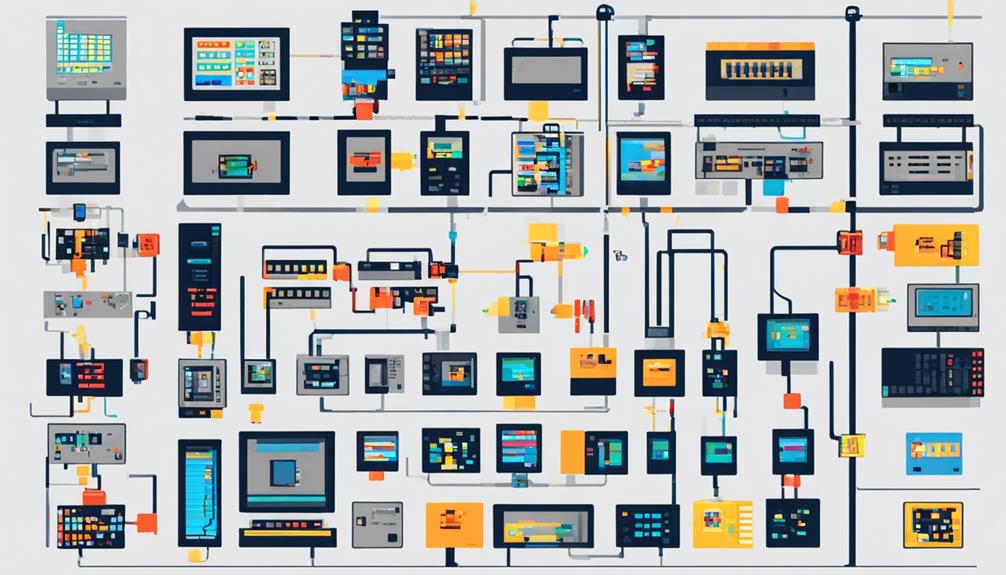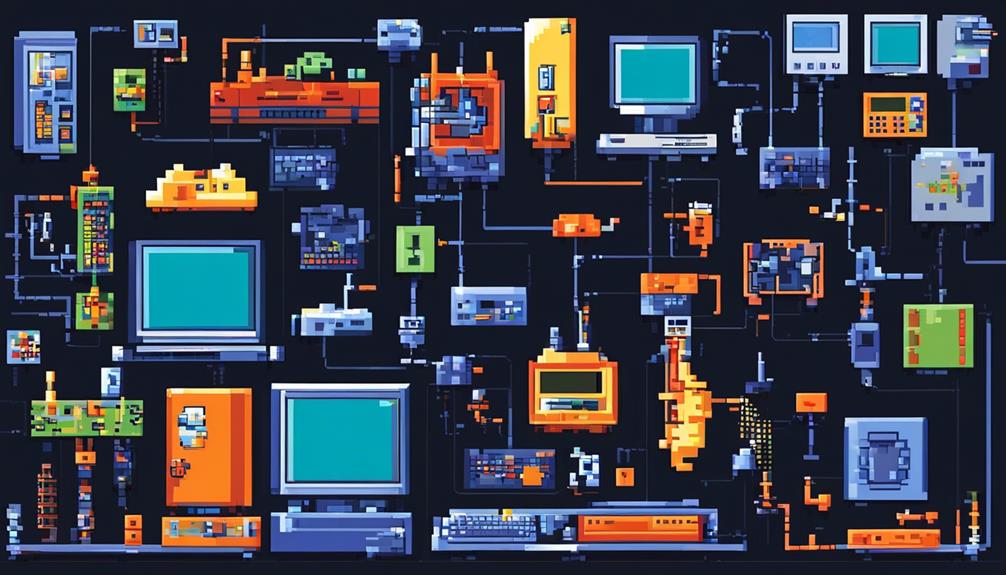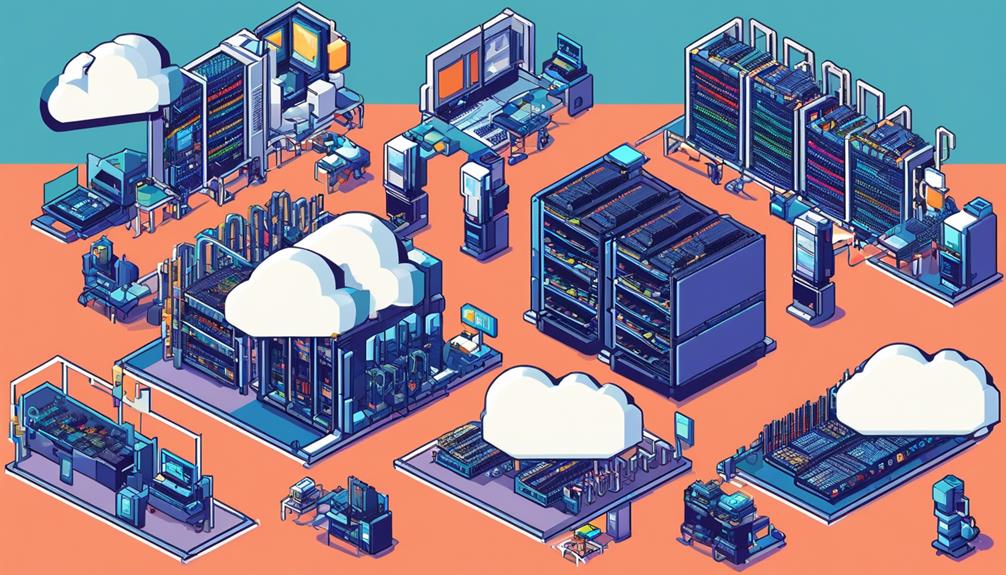In the ever-evolving world of technology, network hardware has undergone significant transformations, shaping the way we communicate and connect.
From the early days of network technologies to the introduction of LAN and WAN, and the evolution of Ethernet standards, the landscape of network hardware has continuously evolved to meet growing demands.
Advancements in switching technology and the integration of network security hardware have further fortified the infrastructure.
But what lies ahead in this dynamic field? What future trends can we expect?
In this discussion, we will explore the fascinating journey of network hardware, from its humble beginnings to the cutting-edge innovations of today, and unravel the exciting possibilities that lie on the horizon.
Key Takeaways
- Ethernet played a crucial role in the development of network hardware, becoming the de facto standard for LANs and ensuring interoperability.
- LANs enabled the centralization and management of data and network resources, facilitating efficient communication and resource sharing on a larger scale.
- WANs enabled the interconnection of geographically dispersed networks, using technologies like point-to-point, frame relay, and ATM, with routers playing a crucial role in directing network traffic.
- Advancements in network hardware, such as switching technology, virtualization, scalability, software-defined networking, merchant silicon, and specialized components like smart NICs, FACs, and DPUs, have improved speed, efficiency, and network management capabilities.
Early Network Technologies

The early network technologies that laid the foundation for modern computer networks include ARPANET, ARCNET, token ring networks, FDDI, and Ethernet. These technologies played a crucial role in the development of network hardware, paving the way for the interconnected world we live in today.
ARPANET, developed by the US Department of Defense, was the first connected computer network. It served as the precursor to the internet and introduced the concept of packet switching, a key element of modern networking.
ARCNET, on the other hand, was a communication protocol for local area networks (LANs) that didn't require homogeneity among connected computers. This made it a versatile and adaptable networking system, contributing to the evolution of network hardware.
Token ring networks were popular in the 1980s and used a ring or star topology for data transmission. IBM's Token Ring technology was a notable example, providing reliable and efficient communication within LANs.
Fiber Distributed Data Interface (FDDI) utilized optical fiber for LAN data transmission, offering superior speeds compared to ARCNET. With a range extending up to 120 miles, FDDI provided long-distance connectivity, further expanding the capabilities of network hardware.
Development of Local Area Networks (LAN)
LANs have revolutionized local connectivity within organizations and campuses, facilitating efficient sharing of resources and data among computers and devices in a limited geographic area. The development of LANs has played a pivotal role in the evolution of network hardware.
Here are some key developments in the field of local area networks:
- Rise of client-server computing: LANs enabled the centralization and management of data and network resources from a dedicated server. This client-server model facilitated efficient data sharing and improved resource utilization.
- Evolution of LAN topologies: LANs initially used simple bus and star topologies. However, as technology advanced, LANs shifted to more sophisticated structures like switched Ethernet. These advancements provided higher speeds and enhanced reliability, enabling seamless communication between devices.
- Adoption of LAN standards: The emergence of LAN standards like Ethernet and IEEE 802.11 (Wi-Fi) led to widespread adoption of LAN technology. These standards enabled seamless wireless connectivity and high-speed data transmission within a close proximity, further enhancing the capabilities of LANs.
- Integration with other networking components: LAN technologies were integrated with other networking components, such as routers and switches. This integration contributed to the formation of complex and interconnected enterprise networks. These networks laid the foundation for modern networking infrastructures, enabling efficient communication and resource sharing on a larger scale.
Introduction of Wide Area Networks (WAN)

Wide Area Networks (WAN) have revolutionized global connectivity by enabling the interconnection of geographically dispersed networks. WANs serve as a vital infrastructure for connecting local area networks (LANs) across wide geographic areas. Various technologies such as point-to-point, frame relay, and ATM are used in WANs to facilitate communication between different corporate branches, providing access to shared resources and applications.
The key components of WANs include routers, switches, and modems. Routers play a crucial role in directing network traffic, ensuring that data packets are delivered efficiently across the network. Switches, on the other hand, enable the connection of multiple devices within a LAN and provide a high-speed data transfer. Modems are responsible for converting digital signals into analog signals, allowing data transmission over traditional telephone lines.
WANs are essential for enabling global connectivity. They support businesses with multiple locations by providing a secure and reliable means of interconnecting LANs. WANs also facilitate remote access to resources and services, allowing employees to connect to the corporate network from any location. This flexibility is particularly valuable for remote workers, enabling them to collaborate with colleagues and access critical information.
Evolution of Ethernet Standards
With the introduction of Wide Area Networks (WAN) revolutionizing global connectivity, it is imperative to explore the evolution of Ethernet standards, a crucial component in facilitating efficient and high-speed data transfer across networks. Ethernet's development in 1973 by Bob Metcalfe at Xerox PARC and subsequent standardization as IEEE 802.3 in 1983 marked the beginning of a new era in network infrastructure. Initially utilizing coaxial cable with speeds of 2.94 Mbit/s, Ethernet quickly evolved to employ twisted pair or fiber optic links, enabling speeds of up to 40 Gb/s. This rapid progression in speed and adaptability made Ethernet an affordable and flexible alternative to previous networking standards.
The evolution of Ethernet standards had a profound impact on network infrastructure, leading to several significant developments.
- Cost-effectiveness: Ethernet's increasing affordability contributed to the decline of token ring systems, making Ethernet the preferred choice for networking.
- Higher speeds: Advancements in networking equipment now offer blazing fast speeds and low latency with technologies like 5G and Wi-Fi 6, which are built on Ethernet foundations.
- Greater adaptability: Ethernet's ability to support different media types, such as twisted pair or fiber optic links, allows for seamless integration with various network devices, enhancing overall network performance.
- Wide adoption: Ethernet's widespread deployment across industries and organizations has made it the de facto standard for local area networks (LANs), ensuring interoperability and ease of integration.
Advancements in Switching Technology

Advancements in switching technology have brought about significant improvements in speed and efficiency, allowing for faster data transfer rates and reduced latency.
Virtualization and scalability have also been enhanced, enabling networks to accommodate the growing demands of cloud computing and virtualized environments.
Additionally, the emergence of software-defined networking (SDN) has revolutionized network management, providing greater flexibility and control through centralized software-based control and automation.
Speed and Efficiency
The continuous development of switching technology has revolutionized network hardware, resulting in significant improvements in speed and efficiency. This has been made possible through various advancements and innovations in the field.
Merchant silicon has become an industry standard for packet forwarding, offering cheaper options and flexibility in network designs.
Smart network interface cards (NICs), functional accelerator cards (FACs), and data processing units (DPUs) are being adopted to offload processing load on servers for optimizing computing and bandwidth costs.
White box switches and fixed form factor switches have become viable options, offering customization and simplicity in network designs.
Open source network OSes (NOSes) have reduced dependence on proprietary hardware, though they face challenges of complexity and lack of support.
These advancements have not only increased network speeds but also improved overall efficiency, allowing for more reliable and cost-effective network solutions.
Virtualization and Scalability
Virtualization and scalability have transformed switching technology, enabling software to run independently of hardware and allowing for easy and cost-effective resource allocation in response to changing demands. This advancement has significantly reduced IT management costs as software can now be deployed and managed separately from the underlying hardware.
Cloud service providers have also leveraged virtualization and scalability to offer IT resources at lower costs, with the ability to easily scale resources up or down based on customer demand. Network Functions Virtualization (NFV) has further contributed to this transformation by shifting network functions from dedicated hardware to software, running on commodity servers.
This enables rapid deployment of network services and optimization of management and performance through virtual networking. Additionally, globally distributed cloud data centers have facilitated optimized application performance by bringing resources closer to end-users.
Software-Defined Networking
Building upon the advancements in virtualization and scalability, the evolution of network hardware has led to the emergence of Software-Defined Networking (SDN), revolutionizing network management.
SDN separates the control plane from the data plane, offering flexibility, cost-effectiveness, and simpler network designs through centralized control and programmability. With SDN, efficient traffic management, dynamic provisioning, and network automation become possible.
Additionally, SDN advancements have given rise to open-source network operating systems, reducing dependence on proprietary hardware. This new approach to network design and management introduces adaptability and scalability, allowing for more efficient and agile networks.
Software-defined networking has become a key technology in modern network infrastructure, providing innovative solutions to address the evolving needs of enterprises and service providers.
Emergence of Wireless Networking

With the emergence of wireless networking, there have been significant advancements in wireless communication technologies, such as Wi-Fi 6 and 5G. These technologies have revolutionized connectivity by enabling flexible and mobile access without the need for physical cables.
As a result, organizations are increasingly integrating wireless networking into their infrastructure to support the growing demand for mobile computing and IoT devices. This integration is reshaping network design and offering new opportunities for connectivity and communication.
Wireless Communication Advancements
Wireless networking has emerged as a result of significant advancements in wireless communication technologies. These advancements have revolutionized both local area networks (LANs) and wide area networks (WANs), leading to the deployment of Wi-Fi 6 and 5G technologies. This has transformed traditional network cabling trends, allowing for increased mobility and flexibility.
Additionally, the emergence of smart Network Interface Cards (NICs), Field-Programmable Access Concentrators (FACs), and Data Processing Units (DPUs) has gained traction, particularly in cloud environments. These devices offload processing loads, improving network efficiency and performance.
Furthermore, the adoption of open source network operating systems (OSes) and white box switches is driving a shift towards platform-driven network strategies. Analysts predict a significant enterprise adoption of smartNICs, FACs, and DPUs, with a projected compound annual growth rate of 115% by 2024.
Impacts on Connectivity
The proliferation of wireless networking has had a profound impact on connectivity, revolutionizing network designs and enabling increased flexibility and mobility.
With the emergence of wireless networking, the reliance on physical cabling has been minimized, allowing for the deployment of LANs and WANs using Wi-Fi 6 and 5G technologies.
This shift towards wireless connectivity has been embraced by enterprises seeking to enhance workplace productivity and collaboration. As a result, there is a growing demand for scalable monitoring and management software solutions to optimize network performance.
The evolution of network hardware will continue to focus on meeting the increasing demand for wireless connectivity and data handling.
Growth of Fiber Optic Networks
Fiber optic networks have experienced significant growth due to their ability to transmit data over long distances at high speeds with minimal loss. This growth can be attributed to several key factors:
- Demand for Faster and Reliable Data Transmission: The increasing need for faster and more reliable data transmission has been a driving force behind the expansion of fiber optic networks. Industries and applications such as telecommunications, data centers, and internet service providers require high-speed connectivity to meet the growing demands of their customers.
- Deployment of Dark Fiber: Dark fiber, which refers to unused optical fiber cables, has become crucial for increasing data center capacity and expanding network infrastructure. By deploying dark fiber, organizations can enhance their network capabilities and support the ever-increasing demand for bandwidth.
- Innovations in Fiber Optic Technology: Ongoing advancements in fiber optic technology, such as increased speeds and improved efficiency, are expected to meet the growing demand for data handling. These innovations are enabling higher data transmission rates, allowing for seamless connectivity and improved network performance.
- Role in Future Data Center Networking: Fiber optic networks play a pivotal role in the future of data center networking hardware. As the demand for data transmission and connectivity continues to rise, fiber optic networks are expected to be the backbone of these networks. The ability to transmit large volumes of data quickly and reliably makes fiber optic networks essential for supporting the transformation of networks.
Evolution of Network Routers

The evolution of network routers has brought about significant advancements in router technology.
One notable change is the transition from proprietary to merchant silicon for packet forwarding, which has allowed for greater flexibility and scalability in router design.
Additionally, the adoption of merchant silicon and white box networking by companies like Arista and Cisco has revolutionized the industry, enabling more cost-effective and customizable router solutions.
Router Advancements
As network technology progresses, advancements in router capabilities have transformed the landscape of network infrastructure. These router advancements have brought about several notable changes and improvements, including:
- Adoption of merchant silicon: Traditional packet forwarding hardware is being replaced with merchant silicon, offering cheaper options and greater flexibility in network designs.
- Offloading processing load: SmartNICs, functional accelerator cards, and data processing units have offloaded processing load on servers, optimizing computing and bandwidth costs, with cloud providers leading the way.
- White box switches and fixed form factor switches: These options allow enterprises to choose their preferred network operating system, customize network designs, and offer simpler failures, reduced footprint, and lower costs.
- Open source network operating systems: With the availability of open source NOSes, there is reduced dependence on proprietary hardware. However, challenges such as complexity and lack of support require a shift from an appliance model to a platform model for wider adoption.
These router advancements have revolutionized the networking industry, enabling more cost-effective and customizable solutions for businesses of all sizes.
Changing Router Technology
With the advancements in router capabilities, the evolution of network routers has brought about significant changes and improvements in network infrastructure.
One major change is the adoption of merchant silicon, which has become an industry standard for packet forwarding. Networking vendors now rely on commodity switching chips from companies like Broadcom and Marvell, allowing for more efficient and cost-effective router designs.
Additionally, router technology has seen the offloading of processing load through the use of smart network interface cards (NICs) and functional accelerator cards (FACs). This offloading helps optimize computing and bandwidth costs, particularly for cloud providers.
Furthermore, the changing router technology has also led to the emergence of white box switches, which enable enterprises to choose their preferred network operating system and customize network designs. However, adoption has been slow due to integration complexity and familiarity with legacy vendors.
Open source network operating systems (NOSes) have also gained attention, reducing dependence on proprietary hardware. However, they face challenges of complexity and lack of support, requiring a shift from an appliance model to a platform model for wider adoption.
Introduction of Network Security Hardware
Network security hardware was introduced to secure network perimeters and protect against sophisticated cyber threats. As technology advanced, organizations realized the need to implement robust security measures to safeguard their networks. The introduction of network security hardware brought about significant advancements in network protection. Here are some key developments in this field:
- Firewalls and Intrusion Prevention Systems (IPS): These were among the first network security hardware solutions deployed to secure network perimeters. Firewalls monitor and control incoming and outgoing network traffic, while IPS systems detect and prevent unauthorized access and malicious activities.
- VPN concentrators and secure gateways: With the rise of remote work, organizations needed secure remote access solutions. VPN concentrators and secure gateways were introduced to ensure encrypted and authenticated connections, allowing remote users to securely access the network.
- Advanced threat protection and behavior-based security analytics: As cyber threats became more sophisticated, network security hardware evolved to include advanced threat protection mechanisms. This involved the use of advanced algorithms and machine learning techniques to detect and mitigate threats in real-time.
- Next-generation firewalls: These integrated application control and advanced threat detection capabilities, providing enhanced network security. Next-generation firewalls not only analyze network traffic but also inspect application-level data to identify potential threats.
Network security hardware has become essential for protecting networks from sophisticated cyber threats. Organizations rely on these devices to secure their network infrastructure, safeguard sensitive data, and ensure the continuity of their operations. As cyber threats continue to evolve, network security hardware will continue to advance to meet the growing security demands of organizations worldwide.
Impact of Virtualization on Network Hardware

Virtualization has significantly influenced the design and functionality of network hardware. With the advent of virtualization technologies, such as software-defined networking (SDN) and network functions virtualization (NFV), the traditional approach to network hardware has been disrupted. This has led to several notable impacts on network hardware, including the adoption of merchant silicon for packet forwarding, the emergence of smartNICs, the rise of white box switches and fixed form factor switches, the utilization of open source network operating systems (OSes), and the availability of more options for network cabling.
To provide a comprehensive overview of the impact of virtualization on network hardware, the following table presents a summary of these key impacts:
| Impact | Description |
|---|---|
| Adoption of merchant silicon | Virtualization has driven the widespread adoption of merchant silicon for packet forwarding in network hardware. This has resulted in cheaper options and increased flexibility in network designs. |
| Emergence of smartNICs | Cloud providers have started adopting smartNICs to optimize computing and bandwidth costs. The enterprise adoption of smartNICs is also expected to grow in the future, further impacting network hardware. |
| Rise of white box switches | White box switches have emerged as a network hardware design option, offering customization and lower costs compared to traditional switches. This has allowed organizations to tailor their networks to their specific requirements. |
| Utilization of open source OSes | Open source network OSes have gained traction in the virtualization era, reducing dependence on proprietary hardware. However, these OSes also come with challenges of complexity and lack of support, which need to be carefully considered. |
| Availability of more cabling options | The impact of virtualization on network hardware is further seen in the availability of more options for network cabling. Wireless and cellular connectivity have emerged as alternatives to traditional cabling, impacting the reliance on specific vendors for cables. |
Integration of Cloud Computing and Networking
The integration of cloud computing and networking revolutionizes the way organizations access and manage network services and resources, allowing for scalable and flexible solutions that reduce reliance on on-premises hardware and infrastructure. This convergence provides numerous benefits for organizations, including:
- Scalability: Cloud-based networking enables organizations to easily scale their network services and resources up or down based on their needs. This flexibility allows for efficient resource utilization and cost optimization.
- Rapid Deployment: Cloud providers offer a wide range of pre-configured networking services that can be rapidly deployed. This eliminates the need for complex hardware setup and configuration, enabling organizations to quickly establish and manage their network infrastructure.
- Simplified Connectivity: The integration of cloud computing and networking facilitates seamless connectivity between various cloud environments. This simplifies the management of multi-cloud architectures and enables efficient data transfer and resource utilization.
- Flexible Deployment: Cloud-based networking allows organizations to deploy network services and resources as per their temporary or changing needs. This flexibility enables them to adapt their network infrastructure to suit different projects or business requirements without the need for significant hardware investments.
Future Trends in Network Hardware

With advancements in technology shaping the future of networking, the evolution of network hardware is witnessing significant trends that enhance performance and efficiency.
One of the major future trends in network hardware is the increased adoption of merchant silicon for packet forwarding. This refers to the use of off-the-shelf chips and components instead of proprietary hardware, resulting in more cost-effective and flexible solutions.
Another emerging trend is the growing enterprise adoption of smartNICs (Network Interface Cards), FACs (Field-Programmable Access Controllers), and DPUs (Data Processing Units) for offloading processing load. These specialized hardware components help improve network performance by handling specific tasks such as security, data processing, and virtualization, relieving the burden on the main server.
There is also a shift towards platform-driven networking strategies, focusing on open-source network operating systems (OSes) and white box switches. This approach allows for greater customization, interoperability, and scalability, as well as reducing dependence on proprietary solutions.
Furthermore, future trends in network hardware include diversification and advancements in network cabling options for LANs (Local Area Networks) and WANs (Wide Area Networks). This ensures higher bandwidth, faster data transfer rates, and improved network reliability.
Lastly, there is an emphasis on fixed form factor switches, collaboration with server teams, and network efficiency optimization. These trends aim to streamline network infrastructure, reduce latency, and enhance overall network performance.
As the Internet of Things (IoT) continues to grow, network hardware will need to adapt to handle the increasing number of connected devices. This will require advancements in network hardware to support the massive data traffic generated by IoT devices and ensure seamless connectivity and communication.
Frequently Asked Questions
What Is the Evolution of a Network?
The evolution of a network, also known as network transformation, refers to the process of adapting and improving network infrastructure and connectivity over time.
It involves the integration of new technologies, such as advanced switching chips, functional accelerator cards, and data processing units, to optimize performance and reduce costs.
Additionally, the adoption of white box switches and open source network operating systems has allowed for greater customization and flexibility in network designs.
Furthermore, the deployment of wireless and cellular connectivity options has expanded networking possibilities.
What Are the Four 4 Different Types of Networking Hardware?
There are four different types of networking hardware that play a crucial role in data center networking capabilities.
These include:
- Switches: Switches direct data packets to and from the right location.
- Modems: Modems enable sending data over a network.
- Routers: Routers allow multiple servers/computers to be part of the same network.
- Physical cables: Physical cables provide physical connections between servers and racks.
These hardware innovations are essential in ensuring efficient and reliable network communication.
What Are the 3 Main Types of Network Hardware?
The three main types of network hardware are switches, modems, and routers.
Switches are responsible for connecting multiple devices within a local area network (LAN) and directing data traffic.
Modems enable communication between the LAN and the internet, converting analog signals to digital and vice versa.
Routers, on the other hand, manage data traffic between different networks, directing packets of data to their intended destinations.
Additionally, wireless routers play a crucial role in providing wireless connectivity to devices within a network.
What Are the 7 Pieces of Network Hardware?
Network hardware consists of various components that facilitate data transfer and connectivity within a network. These components include:
- Network switches: Crucial for routing data packets to their correct destinations, ensuring efficient communication within the network.
- Routers: Responsible for directing network traffic between different networks, such as local area networks (LANs) and wide area networks (WANs).
- Modems: Allow computers to connect to the internet by converting digital signals into analog signals that can be transmitted over telephone lines or cable lines.
- Physical cables: Provide the physical connections between devices in a network, such as Ethernet cables and fiber optic cables.
- Servers: Centralized computers that store and distribute resources, such as files, applications, and databases, to other devices in the network.
- Network interface cards (NICs): Enable devices to connect to a network by providing a physical interface for transmitting and receiving data.
- Firewalls: Protect networks from unauthorized access and potential threats by monitoring and controlling incoming and outgoing network traffic.
Each of these pieces of hardware plays a vital role in establishing and maintaining a robust and reliable network infrastructure.
